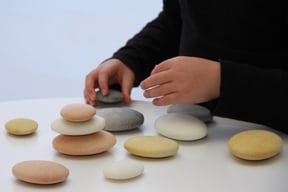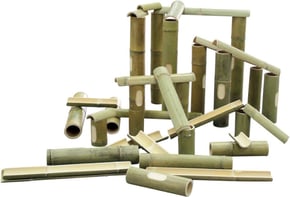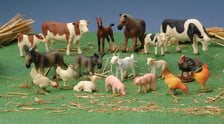 Possibly one of the oldest kinds of play in the history of mankind, loose parts play is a spontaneous and creative way in which children engage with their environment. The term “loose parts” was coined by a British architect, Simon Nicholson, to describe materials which are used in an open-ended way. Creativity and discovery, according to Nicholson, depend on the presence of the variables available in the environment.
Possibly one of the oldest kinds of play in the history of mankind, loose parts play is a spontaneous and creative way in which children engage with their environment. The term “loose parts” was coined by a British architect, Simon Nicholson, to describe materials which are used in an open-ended way. Creativity and discovery, according to Nicholson, depend on the presence of the variables available in the environment.
In loose parts play children interact with, and manipulate, a unique collection of items or “parts”. These parts can be completely unrelated and their size and nature can vary depending on the users and setting. They can be offered by an educator or spontaneously collected by children.
Playing and experimenting with open-ended materials encourages creativity and imagination. New skills in planning, communication and problem solving are developed - and because there is no prescribed way to use the parts, children make the decisions. They learn, through play, at the level that they are ready for - and naturally stretch themselves by setting their own goals and challenges.
How you can encourage Loose Parts Play - and how to get the best out of it:
 Loose parts play can be solitary or happen in a group of any size. It can start small, with a box or basket of odd items, but be prepared for your collection to take on a life of its own, run over into new sets, and become a firm favourite. If your centre is flexible in allowing equipment to be taken from their designated area to another, you may be able to leave it up to the children to collect what they need to furnish their own play scenario. You may then offer items that could add value to the collection. Alternatively, you could tailor the experience by selecting specific items and offering them as a starting point to work towards a goal. For instance, if social skills and co-operation need to be encouraged in an early childhood centre, educators may set up a number of interesting and inviting items in an area large enough for the group they have in mind, and then specifically monitor and support co-operative play in that area.
Loose parts play can be solitary or happen in a group of any size. It can start small, with a box or basket of odd items, but be prepared for your collection to take on a life of its own, run over into new sets, and become a firm favourite. If your centre is flexible in allowing equipment to be taken from their designated area to another, you may be able to leave it up to the children to collect what they need to furnish their own play scenario. You may then offer items that could add value to the collection. Alternatively, you could tailor the experience by selecting specific items and offering them as a starting point to work towards a goal. For instance, if social skills and co-operation need to be encouraged in an early childhood centre, educators may set up a number of interesting and inviting items in an area large enough for the group they have in mind, and then specifically monitor and support co-operative play in that area.
What can I include in a Loose Parts collection at my Early Childhood Centre?
Anything, really! Your list will vary according to the context and goals of your centre. We suggest that you start off with an idea or a few central parts and build your collection around that with a mix of purchased and recycled or found items.
Larger items such as shovels and buckets, wooden or plastic animals, pulleys and rope offer a good basis for exploration in an outdoor setting. Discarded kitchen items, pine cones, acorns, flowers, pieces of wood, stones, plastic crates and old sheets could be added for interest.
 For a confined space a few items from our Animal Discovery or Families range and some wooden parts from our Natural First Skills range could form a high-interest basis for loose parts sets. The next step would be adding some items of different sizes and textures, such as seashells, wooden blocks, recycled containers, scraps of wool, felt, cardboard, and other household items. Super Sensory Beanbags or Small Rattan Balls from our sensory collection would also be a wonderful addition to an inside loose parts collection.
For a confined space a few items from our Animal Discovery or Families range and some wooden parts from our Natural First Skills range could form a high-interest basis for loose parts sets. The next step would be adding some items of different sizes and textures, such as seashells, wooden blocks, recycled containers, scraps of wool, felt, cardboard, and other household items. Super Sensory Beanbags or Small Rattan Balls from our sensory collection would also be a wonderful addition to an inside loose parts collection.
Finally, do not forget to take a look at the trays and baskets in our Natural Storage category. These beautiful containers will not only serve as a great way to store your collections in between sessions, but they are likely to be popular items for incorporating into the play experience as well.
Loose parts play is a wonderful way for young explorers to plan, create, solve problems, and to challenge themselves to learn new skills. A good collection of odd parts can be the start of many imaginative adventures and projects.
Written by Hanlie Kruger Grad. Dip. (ECE)



